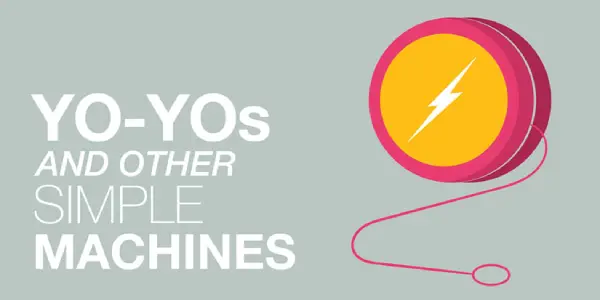
Mr. Electric explains how yo-yos and other simple machines demonstrate basic physics principles.
|
If you’ve ever played with a Duncan yo-yo, you have Donald Duncan Sr. to thank for manufacturing the modern version of this basic little toy in 1930. However, like many simple machines we take for granted today, yo-yos have been around for thousands of years. Though they went by different names back then – including quizzes, bandalores and Jou-Jous – the yo-yo has always essentially been a string wound around an axle connected to two wheels.
The average person may believe the functionality of a yo-yo is limited to learning tricks to impress your friends, but like so many simple machines, yo-yos form the foundation of other, more complex systems. Surprised? Learn how yo-yos work and what technology wouldn’t exist without the invention of yo-yos and other simple machines.
How Yo-Yos Work
It might look like nothing more than a simple toy, but a yo-yo is an energy-converting machine:
- When you hold a yo-yo in your hand, it possesses potential energy because it’s a few feet above the ground.
- When you release the yo-yo, it falls toward the ground, converting a portion of this potential energy into kinetic energy of movement. The yo-yo also spins, converting the other portion of potential energy into kinetic energy of rotation.
The yo-yo’s momentum not only gets it to the ground; it also helps the yo-yo climb partway back up the string. If you tug on the string at just the right moment, you can make the yo-yo go up and down virtually without endlessly. Your tugging supplies a bit more energy to help overcome other forces at play, including friction, air resistance, and gravity.
Simple Machines Found in Compound Systems
Simple machines are defined as devices that have only one part and accomplish only one thing. The six simple machines most authorities recognize include:
- Levers (crowbars, nutcrackers)
- Pulleys (used for raising and lowering Venetian blinds and flags on flag poles)
- Wheels and axles (doorknobs, screwdrivers, water wheels, steering wheels, water well cranks)
- Inclined planes (any sloping surface)
- Wedges (axes, door stops)
- Screws (metal screws, jar lids, light bulb sockets)
These simple machines form the basis of so many compound systems. A yo-yo – which is a simple wheel and axle machine – is the basis for several compound systems. Wheels and axles are used in some surprising places:
- Fishing would be a lot more difficult without the reel that winds and unwinds fishing line. The reel is a wheel and axle that works as a pulley.
- Bicycles work through a combination of pulleys, wheels, and axles. This is what allows you to peddle forward only a small amount while making the wheels spin forward several feet along the ground.
- Cars combine a wide variety of simple machines to form a much more complex system. The steering wheel itself is an example of a simple wheel and axle machine, and of course, each set of tires are connected to an axle to transfer energy and allow the car to move forward.
- Even seemingly simple inventions such as wheelbarrows, can openers, and egg beaters incorporate the same wheel and axle principle that allows a yo-yo to work, along with levers and wedges to make them compound machines.
When you look more deeply at the world around you, you realize that simple and compound machines are everywhere. They’re the systems that propel our world forward! Remember this as you spin your yo-yo around and learn new tricks to show your friends. When it comes to simple and compound machines in your home, contact Mr. Electric for the best service.

